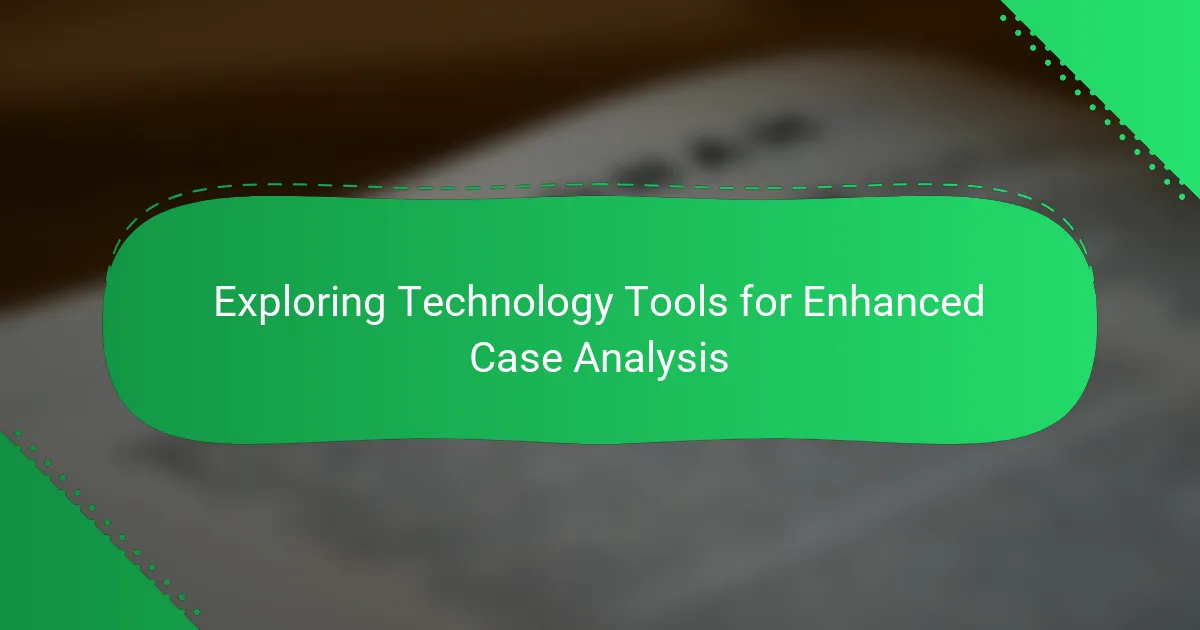Technology tools for enhanced case analysis encompass software and applications that aid in data collection, organization, and evaluation, ultimately streamlining the case analysis process. Key tools include case management systems, data visualization tools, and analytical software, which improve efficiency and accuracy in analyzing case-related information. Notable examples are Tableau and Microsoft Power BI for data visualization, and Clio and MyCase for case management. Additionally, collaboration platforms like Slack and Microsoft Teams facilitate team communication, further enhancing the analysis process. These technology tools not only assist in identifying trends and patterns but also contribute to better decision-making and improved case outcomes.

What are Technology Tools for Enhanced Case Analysis?
Technology tools for enhanced case analysis include software and applications that facilitate data collection, organization, and evaluation. These tools enable analysts to streamline the case analysis process. Common examples are case management systems, data visualization tools, and analytical software. Case management systems help in tracking case progress and documentation. Data visualization tools assist in presenting complex data in an understandable format. Analytical software allows for in-depth statistical analysis and modeling. Additionally, collaboration platforms enhance communication among team members. These tools improve efficiency, accuracy, and overall case outcomes.
How do these tools improve case analysis processes?
These tools improve case analysis processes by automating data collection and analysis. Automation reduces the time required for manual data entry and processing. This efficiency allows analysts to focus on interpreting results rather than gathering information. Additionally, these tools enhance accuracy by minimizing human error in data handling. They also provide advanced analytical capabilities, such as predictive modeling and data visualization. These features help in identifying patterns and trends that may not be immediately obvious. Furthermore, collaboration tools facilitate communication among team members, leading to more comprehensive case evaluations. Overall, technology tools streamline workflows and enhance the quality of case analysis outcomes.
What specific features do these tools offer for analysis?
These tools offer advanced data visualization capabilities. They enable users to create charts, graphs, and dashboards for better insights. Many tools include real-time data analysis features. This allows for immediate interpretation of data trends. Additionally, they provide statistical analysis functionalities. Users can perform regression analysis, hypothesis testing, and more. Some tools offer machine learning integration for predictive analytics. This enhances decision-making based on historical data patterns. Furthermore, collaboration features are often included. Teams can share findings and work together seamlessly.
How do these features enhance decision-making in case analysis?
Features in technology tools enhance decision-making in case analysis by providing data-driven insights. These insights allow analysts to evaluate multiple scenarios quickly. Advanced analytics tools can process large datasets efficiently. Visualization features help in identifying patterns and trends. Real-time data access enables timely decisions. Collaboration tools facilitate communication among team members. Predictive analytics can forecast outcomes based on historical data. These capabilities lead to more informed and accurate decision-making.
Why is technology integration crucial for case analysis?
Technology integration is crucial for case analysis because it enhances data accuracy and efficiency. It allows for real-time data collection and analysis. This leads to more informed decision-making. Advanced tools can process large datasets quickly. For instance, analytics software can identify trends that manual analysis may miss. Furthermore, technology facilitates collaboration among team members. Cloud-based platforms enable sharing insights instantly. According to a study by McKinsey, organizations that leverage technology in analysis improve their performance by up to 20%. Therefore, technology integration is essential for effective case analysis.
What challenges do traditional methods face without technology?
Traditional methods face significant challenges without technology. These methods often rely on manual processes, which can lead to errors. For instance, data entry mistakes can compromise the accuracy of case analysis. Additionally, traditional methods tend to be time-consuming. This results in delays in decision-making and response times. Furthermore, the lack of real-time data access limits the ability to make informed choices quickly. Communication barriers also arise when relying solely on traditional methods. Collaboration can be hindered, affecting overall efficiency. Lastly, traditional methods may struggle to scale effectively as case complexity increases.
How can technology overcome these challenges?
Technology can overcome challenges in case analysis by streamlining data collection and enhancing collaboration. Advanced software tools enable efficient gathering of relevant information from diverse sources. Cloud-based platforms facilitate real-time collaboration among team members, improving communication and decision-making. Data analytics tools provide insights that help identify patterns and trends in case data. Artificial intelligence can automate repetitive tasks, allowing analysts to focus on critical thinking. Machine learning algorithms can predict case outcomes based on historical data, increasing accuracy in assessments. Additionally, visualization tools can present complex data in an understandable format, aiding in analysis and presentation. These technological advancements collectively enhance the effectiveness and efficiency of case analysis processes.

What types of technology tools exist for case analysis?
Various technology tools exist for case analysis. These tools include data analytics software, case management systems, and visualization tools. Data analytics software helps in analyzing large datasets to identify trends. Popular examples are Tableau and Microsoft Power BI. Case management systems organize and track case-related information. Tools like Clio and MyCase are widely used in legal contexts. Visualization tools assist in presenting data visually for better understanding. Examples include Lucidchart and Microsoft Visio. Collaboration platforms also facilitate case analysis by enabling team communication. Tools such as Slack and Microsoft Teams support real-time collaboration. These technology tools enhance efficiency and accuracy in case analysis.
What software solutions are available for case analysis?
Several software solutions are available for case analysis. Popular options include CaseGuard, which specializes in case management and analysis. Another solution is IBM Watson, known for its advanced data analytics capabilities. Tableau offers visualization tools that help in analyzing case data effectively. Additionally, SAS provides comprehensive analytics software suitable for case studies. Microsoft Power BI is also widely used for data visualization and analysis. Each of these tools supports various analytical functions, enhancing the case analysis process.
How do these software solutions differ in functionality?
Different software solutions for case analysis vary in their functionality. Some focus on data visualization, allowing users to create graphs and charts easily. Others emphasize document management, streamlining the organization and retrieval of case files. Certain tools offer advanced analytics, providing predictive insights based on historical data. Collaboration features are also a key differentiator, with some solutions enabling real-time communication among team members. Integration capabilities with other software can vary significantly, affecting overall workflow efficiency. User interfaces differ, impacting ease of use and learning curve. Furthermore, customization options allow some software to be tailored to specific case types or industries, enhancing their utility.
What are the leading software tools currently in use?
The leading software tools currently in use for enhanced case analysis include Microsoft Excel, Tableau, and SAS. Microsoft Excel is widely used for data analysis and visualization. Tableau excels in creating interactive dashboards and visual analytics. SAS is known for advanced statistical analysis and data management. According to a 2023 report by Gartner, these tools dominate the market due to their robust features and user-friendly interfaces. They are integral in various industries for data-driven decision-making.
What hardware tools support case analysis efforts?
Hardware tools that support case analysis efforts include computers, servers, and specialized data collection devices. Computers enable data processing and analysis through various software applications. Servers facilitate the storage and management of large datasets, ensuring accessibility for analysis. Data collection devices, such as scanners and mobile devices, assist in gathering information efficiently. These tools enhance the speed and accuracy of case analysis. For example, high-performance computers can process complex algorithms quickly, improving analysis outcomes. Additionally, servers can handle multiple users accessing data simultaneously, increasing collaboration efficiency.
How does hardware impact the efficiency of case analysis?
Hardware significantly impacts the efficiency of case analysis by determining processing speed and data handling capabilities. High-performance hardware enables faster data processing, leading to quicker analysis results. For instance, advanced processors can execute complex algorithms more rapidly than standard ones. Additionally, ample RAM allows for handling larger datasets without lag. Efficient storage solutions, such as SSDs, further enhance data retrieval speeds. A study by Gartner highlights that organizations using upgraded hardware can improve analytical performance by up to 50%. Thus, the choice of hardware directly influences the overall effectiveness and speed of case analysis.
What are the essential hardware components needed?
The essential hardware components needed for enhanced case analysis include a computer, monitor, and storage device. A computer serves as the central processing unit for running analysis software. The monitor displays data, graphs, and reports for easy interpretation. A storage device, such as an external hard drive or cloud storage, ensures data is saved and accessible. Additional components may include a printer for producing reports and a reliable internet connection for online research. These components collectively support efficient data processing and analysis.

How do specific technology tools enhance case analysis?
Specific technology tools enhance case analysis by providing advanced data processing capabilities. These tools enable analysts to collect, organize, and analyze vast amounts of information efficiently. For instance, software like Tableau allows for visual data representation, making it easier to identify trends and patterns. Natural Language Processing tools can analyze text data to extract relevant insights quickly. Machine learning algorithms can predict outcomes based on historical data, improving decision-making accuracy. Research by Gartner indicates that organizations using data analytics tools see a 5-10% increase in operational efficiency. Overall, technology tools streamline the case analysis process, leading to more informed conclusions and actions.
What are the benefits of using data visualization tools?
Data visualization tools enhance understanding of complex data. They simplify the presentation of large datasets. This makes it easier for users to identify trends and patterns. Visual representations can increase retention of information. According to a study by the University of Minnesota, individuals recall 65% of information presented visually compared to 10% when presented in text form. These tools also facilitate faster decision-making. Users can quickly interpret visual data, leading to more informed choices. Additionally, data visualization tools promote collaboration among teams. Shared visual insights enable more effective discussions and strategy development.
How do these tools aid in understanding complex data?
These tools aid in understanding complex data by simplifying information processing. They visualize data trends and patterns effectively. This visualization helps users to identify anomalies quickly. Tools often provide interactive dashboards for real-time insights. They can aggregate large datasets into manageable formats. This aggregation enhances comprehension and decision-making. Advanced analytics features enable predictive modeling and scenario analysis. Such capabilities allow users to forecast outcomes based on historical data.
What are some popular data visualization tools used in case analysis?
Some popular data visualization tools used in case analysis include Tableau, Power BI, and QlikView. Tableau allows users to create interactive and shareable dashboards. Power BI integrates with Microsoft products and offers extensive data modeling capabilities. QlikView provides associative data indexing, enabling users to explore data freely. Each tool supports various data sources and offers features that enhance analytical insights. These tools are widely recognized for their effectiveness in presenting complex data visually.
How do collaboration tools facilitate teamwork in case analysis?
Collaboration tools facilitate teamwork in case analysis by enabling real-time communication and information sharing. These tools allow team members to discuss findings and strategies instantly. Features like document sharing and editing enhance collaborative efforts. Task management functions help assign roles and track progress efficiently. Centralized data storage ensures all team members access the same information. This reduces miscommunication and enhances decision-making. Studies show that teams using collaboration tools are 30% more productive in project completion. Overall, these tools streamline the case analysis process and improve team dynamics.
What features should collaboration tools include for effective analysis?
Collaboration tools should include features such as real-time data sharing, integrated analytics, and customizable dashboards for effective analysis. Real-time data sharing allows team members to access and contribute information instantly. Integrated analytics provide insights from data without needing separate software. Customizable dashboards enable users to visualize data in a way that suits their needs. Additionally, version control is crucial to track changes and maintain data integrity. User permissions ensure that sensitive information is accessible only to authorized personnel. Communication features, like chat and video conferencing, facilitate discussions around the analysis. These features collectively enhance collaboration and improve the quality of analysis.
How do these tools improve communication among team members?
These tools improve communication among team members by facilitating real-time collaboration. They enable instant messaging, video conferencing, and file sharing. Team members can discuss ideas and solve problems quickly. This immediacy reduces misunderstandings and delays. Tools like Slack or Microsoft Teams offer organized channels for topic-specific discussions. Research shows that effective communication tools increase productivity by up to 25%. Enhanced communication leads to better project outcomes and team cohesion.
What are best practices for implementing technology tools in case analysis?
Best practices for implementing technology tools in case analysis include thorough needs assessment, user training, and ongoing support. Conduct a needs assessment to identify specific requirements for the case analysis process. This ensures that the selected technology aligns with the goals of the analysis. User training is essential to maximize the effectiveness of the technology tools. Training sessions should cover functionality and best practices for usage. Ongoing support is necessary to address any issues that arise during implementation. Regular updates and maintenance of the technology tools help maintain their effectiveness. Additionally, soliciting user feedback can guide future improvements. These practices enhance the overall efficiency and accuracy of case analysis.
How can organizations select the right tools for their needs?
Organizations can select the right tools for their needs by assessing their specific requirements. First, they should identify their objectives and the problems they aim to solve. This involves understanding the tasks that need automation or enhancement. Next, they must evaluate the available tools based on features, usability, and compatibility with existing systems. Cost considerations are also crucial; organizations should analyze their budget constraints. Additionally, seeking user feedback and reviews can provide insights into the effectiveness of the tools. Finally, conducting trials or pilot tests can help determine if a tool meets the organization’s needs effectively.
What common pitfalls should be avoided during implementation?
Common pitfalls to avoid during implementation include inadequate planning and lack of stakeholder engagement. Inadequate planning can lead to missed deadlines and budget overruns. Stakeholder engagement is crucial for gathering requirements and ensuring alignment. Failing to provide proper training can result in user resistance and underutilization of the technology. Additionally, neglecting to test the technology thoroughly may lead to unforeseen issues post-implementation. Poor communication can create misunderstandings and hinder collaboration among team members. Lastly, overlooking ongoing support and maintenance can affect long-term success and adaptability of the technology.
Technology tools for enhanced case analysis are software and applications designed to improve data collection, organization, and evaluation processes. This article explores various technology tools, including case management systems, data visualization tools, and analytical software, highlighting their features and benefits in automating data handling, enhancing accuracy, and facilitating collaboration among team members. It also discusses the importance of technology integration in overcoming challenges faced by traditional methods and outlines best practices for selecting and implementing these tools effectively. Overall, the article provides a comprehensive overview of how technology enhances the efficiency and quality of case analysis outcomes.



